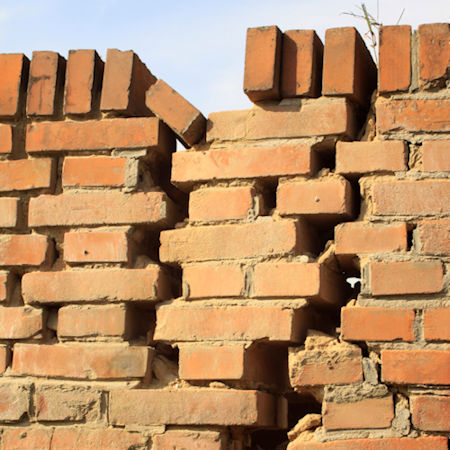Pinned-Between or Crushed-by Hazards
Workers may be pinned between or crushed by equipment, machinery, and structures if parts break, power is lost, or structures become unstable.

For instance, a crane boom, scaffold, trench plates, or a wall might unexpectedly collapse.
During demolition, your employer must ensure any stand-alone walls more than one story must have lateral bracing unless the wall was designed to be stand-alone and is otherwise in a safe condition to be self-supporting.
- Jacks must have a firm foundation. If necessary, the base of a jack must be blocked or cribbed. After a load has been raised, it must be cribbed, blocked, or otherwise secured at once.
- When balling or clamming is being performed, only the personnel necessary for the work must be allowed in the work area.
- Your employer must make sure that proper bracing is used between heavy plates used as shoring in a trench.
- The path of travel must be carefully arranged when loading/unloading, stacking, and storing materials so that no workers will be caught between materials and moving equipment or between materials and a wall.
- be aware at all times of the equipment around you and stay a safe distance from it;
- never place yourself between moving materials and an immovable structure, vehicle, or stacked materials;
- make sure all loads carried by equipment are stable and secured;
- never walk or work under a load that is suspended;
- stay out of the swing radius of cranes and other equipment; and
- wear a seat belt, if required, to avoid being thrown from a vehicle and then potentially being crushed by the vehicle if it tips over.
Description of the accident
The son of the owner of a commercial drywall construction company, an employee of the company, was preparing an aerial lift for a job and had replaced two battery terminals. He had raised the aerial boom and was reaching toward the battery compartment across the metal enclosure that houses the lift's toggle controls when the boom dropped and pinned him to the control panel. His father discovered him and summoned emergency responders, but he died at the site.

Investigation Findings
- The lift's emergency valve, hydraulic hoses and fittings, and electrical wiring were inspected after the accident and were not defective; however, the on/off key switch had been bypassed so that the operator could use the toggle switches without using the key.
- The battery charging system was missing a fuse that would stop the system from charging, and the spring-loaded toggle switches that controlled the boom did not have guards to prevent accidental contact.
- The employee did not use lockout procedures while he was working on the lift and did not block the boom to prevent it from dropping.
- The owner had not reviewed the lift's instruction manual with the victim or other company employees.
- Although the company had more than 10 employees, it did not have a safety committee.
The accident resulted in the OSHA violations listed below:
- The employer failed to ensure that employees did not remove or tamper with required safety devices.
- The employer did not develop, document, and require employees to use lockout procedures to control hazardous energy during maintenance work.
- The employer had more than 10 employees but did not have a safety committee.(State of Oregon requirement)
Knowledge Check Choose the best answer for the question.
2-4. During demolition, your employer must ensure non-designed stand-alone walls over one story _____.
- have lateral bracing
You forgot to answer the question!
